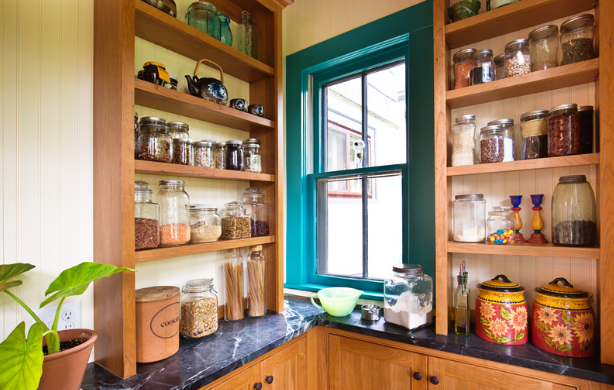Kitchens are one of the hardest working rooms in a home, and they also need to store a lot of stuff, including food. The typical place for food storage is a pantry, but not every kitchen has one. If you don’t have a pantry, or it’s too small to hold all your food, are you destined for a cluttered kitchen? Nope. Try these food storage ideas to keep your kitchen tidy and working smoothly.
1. Freestanding Furniture Pieces
Purchase a freestanding cabinet with shelves or a baker’s rack to house various dry goods. Furniture options with doors make it a breeze to hide unsightly jars, cans, and boxes of snacks, cereal, and more. Think outside the box when choosing a piece. It doesn’t have to say “pantry” in the description to hold food. Look for linen cabinets, wardrobes with shelving, or convert a bookcase into food storage (use a curtain and tension rod to keep items out of sight).
2. Use Cabinets or Drawers
Assess your kitchen inventory and see if you can free up some space in a cabinet or drawer. Drawers are useful for storing things like wax paper, boxes of plastic baggies, aluminum foil, spices, and various snacks. Use organizers to keep things tidy and easy to grab. Avoid using spaces next to your stove or oven, so the heat doesn’t compromise certain food items.
This step may require you to do a little decluttering in your kitchen first, but that could be a welcome opportunity. If your kitchen is like most, it has unused small appliances, duplicate utensils, and a hodge-podge of cups, plates, and bowls you don’t need.
3. Put Backstock in a Nearby Closet
If you store non-foodstuffs in your kitchen (paper towels, parchment paper, etc.) and buy in bulk, keep the stock back in another location. Choose a closet near the kitchen so you don’t need to trek through your house every time you need to restock. If you’re extremely limited on space in your home, buying in bulk may not be the best option for you, so consider your shopping lists carefully.
4. Maximize Vertical Space in Your Kitchen
Install floating shelves or wall baskets to hold various items. Understandably, you don’t want to display your canned goods and cereal boxes, but it’s possible to get creative. For example, select a few attractive food storage canisters to hold various staples you often use, like sugar, flour, and oats.
Different shapes and colors of pasta can double as decor when you house them in airtight glass jars. Wall baskets are perfect for holding produce like oranges, lemons, and other colorful fruits and vegetables. Carry your use of vertical space into cabinets, freestanding furniture pieces, and a pantry (if you have one). Utilize the back of doors, side walls, etc.
5. Add Cubby Cabinets
If you have a bigger budget for your food storage dilemma, consider installing cubby cabinets above your existing uppers. If you have empty space between your ceiling and cabinets or a soffit that’s purely a placeholder, transom cabinets provide extra storage in an otherwise wasted space.
Of course, unless you’re 7 feet tall, these high cabinets aren’t the easiest to access. Therefore, move items you don’t use often (like holiday serving dishes) to the cubby cabinets to free up more accessible places for food storage.
With a bit of creativity and these handy tips, you can transform your kitchen into a well-organized and efficient space. Whether it’s repurposing furniture, maximizing vertical space, or cleverly utilizing cabinets and drawers, there are plenty of ways to keep your food storage in check. So, say goodbye to kitchen clutter and hello to a tidy, functional kitchen that meets all your storage needs.
For more Tips & Tricks, check out our blog page!
Check us out on Facebook for constant updates, spotlights, and news!

 Facebook
Facebook
 X
X
 Pinterest
Pinterest
 Copy Link
Copy Link






